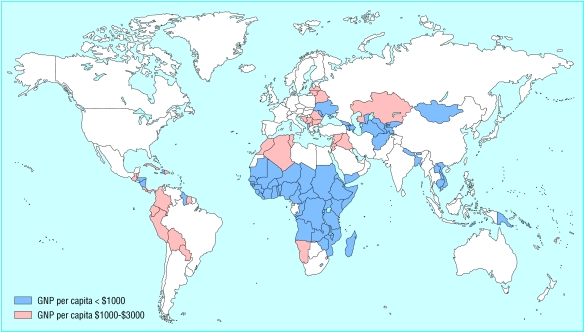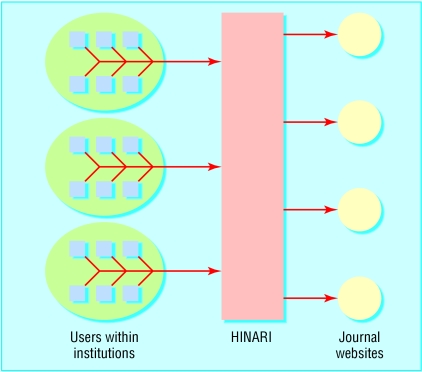Short abstract
The unequal distribution of health care is being addressed by an electronic initiative that makes medical journals available free of charge to health workers in developing countries
Health care is unequally distributed between the developed and developing worlds, which is matched by unequal distribution of health information. The information gap between rich and poor countries is so great it has been argued that “providing access to reliable health information for health workers in developing countries is potentially the single most cost effective and achievable strategy for sustainable improvement in health care.”1 So far, the most successful initiative to bridge this gap is the Health InterNetwork Access to Research Initiative (HINARI).
A short history
“In HINARI lies the seed of a knowledge revolution,” said Gro Harlem Brundtland, director of the World Health Organization. “The knowledge gap between rich and poor must be overcome if we are to reduce poverty. The information made available through HINARI will help developing countries in improving skills, developing research and, by extension, to save lives.”2
In April 2000, a group of researchers from developing countries, convened by the World Health Organisation (WHO), concluded that the best way to help with their information problems was to improve their access to the published literature (Aronson B, personal communication). At that time, 56% of institutions in the lowest income countries had no current subscriptions to international journals and 21% averaged only two journal subscriptions.3
WHO realised that the recent revolution in information technology had opened up an opportunity for addressing information poverty. Compared with the £50 or more that it costs to send a paper copy of a weekly journal to an institution in Africa for a year, it costs publishers virtually nothing to give that same institution free access to an electronic edition of a journal.4 Publishers in the developed world are unlikely to incur significant financial loss by offering free or reduced price access to their online material, but they may benefit from the raised exposure of their journals and an improved public image.
The WHO, in collaboration with the BMJ Publishing Group, approached the world's six largest medical journal publishers to try to improve access to scientific information for researchers in the developing world through online provision.5 In a meeting at the United Nations in March 2001, the six publishers (Blackwell, Elsevier Science, Harcourt Worldwide STM Group, Wolters Kluwer International Health & Science, Springer Verlag, John Wiley) agreed to provide access to all of their online journals for free or at deeply discounted rates through HINARI.
HINARI was launched in January 2002 and initially allowed not-for-profit institutions in countries with a gross national product (GNP) per capita of less than US$1000 (£556; €825) per year (as calculated in the World Bank's report in 2001) to receive free online access to more than 1500 journal titles. In January 2003, the initiative expanded to allow institutions in countries with a GNP per capita of between $1000 and $3000 per year to access the online material now available through HINARI, estimated to be worth more than $750 000, for $1000 (fig 1). Money raised from these small fees is being used to train librarians and researchers in information technology so that the best use can be made of the information now available to them. The number of publishers involved in HINARI has enlarged to 50, providing access to more than 2400 journals and other full text resources. HINARI can now be used by more than 1100 institutions in 102 countries (out of a total of 113 eligible countries).
Fig 1.
Countries with access to HINARI
How HINARI works
HINARI allows health and medical institutions to join the initiative by filling in a simple online form.6 After processing and authentication, WHO staff issue the institution with a password. Individuals at the institution wishing to use HINARI then approach their librarian (or equivalent) for the password. Through the HINARI web portal, they have free access to full text biomedical and related social science articles supplied from publishers' websites (fig 2). The portal also allows users to conduct PubMed (Medline) literature searches through the National Library of Medicine, search for journals based on subject, and access the full text papers directly through HINARI.
Fig 2.
How HINARI works. Individuals receive a password from their institution which allows them to log on to HINARI; through the HINARI web portal they can access publishers' online journal websites
Has HINARI worked?
It is estimated that HINARI users downloaded more than one million articles in 2003. Usage depends on good internet connectivity rather than the economic strength of the country, with some very low income countries, like Ethiopia, being among the biggest users.3 The high cost of reliable internet access has limited the expansion of services, but some institutions have been able to use their eligibility for HINARI to support their applications for funding from donors.
No formal evaluation of HINARI has yet been done; one will start at the end of 2005. Anecdotal feedback has been positive. The box outlines some potential benefits of HINARI, but methodological difficulties in evaluation mean that a direct connection between improved access to scientific information and an improvement in health is unlikely to be proved.
Continuing problems
HINARI cannot reach everyone who might benefit. In many countries internet access is slow, expensive, and unreliable. Many poor institutions carrying out valuable research in countries with a GNP per capita of over $3000 per year are not eligible to use HINARI Information is often not available in electronic format—especially if it has been produced locally. The electronic format may be unsuitable for certain uses—for example, medical students in the developing world may benefit more from printed textbooks than from virtual textbooks that are only accessible from an unreliable internet connection at medical school.
HINARI may also pose problems to researchers and health professionals working in the developing world. Allowing unrestricted access to much of the world's medical literature may produce an information overload and lead to valid and relevant information being difficult to find.7 This is particularly important for people who are not experienced in using information technology and reading primary research (but this problem occurs in the developed world too).
Some valuable journals of specific relevance to the developing world (tropical medicine journals, for example) may not be available through HINARI as this may compromise publishers' commercial viability. Also, in a few countries, publishers withhold some journals because the sales of these journals are significant in these countries. However, institutions in these few countries are still able to access at least most of the key general medical and scientific journals without restrictions.
Other free initiatives
Alternative approaches for providing free or highly discounted rates to online journals exist. They include the Programme for the Enhancement of Research Information (PERI; www.inasp.info/peri/) managed by the International Network for the Availability of Scientific Publications (INASP); Electronic Information for Libraries (eIFL; www.eifl.net/); and the Ptolemy Project (www.utoronto.ca/ois/myweb9/).
The BMJ Publishing Group offers free access to its journals for users in the world's 118 poorest countries.8 This differs from HINARI in offering countrywide free access without the need for passwords. Many other journals sharing the group's electronic publisher, Highwire Press, provide a similar service (see http://highwire.stanford.edu/lists/devecon.dtl for a list of these publications).
What might HINARI achieve?
Reduce feelings of isolation among scientists in the developing world
Enable researchers in the developing world to improve the quality of their research
Help stop or slow the “brain drain” of scientists from the developing world to the developed world
Improve teaching and training of current and future health professionals and scientists
Allow developing world scientists to provide more accurate and informed advice to policy makers
Reduce the “publishing gap” between researchers in the developed world and developing world by improving the likelihood of publication in international journals
Improve quality of locally produced journals
Help create an information culture that uses an evidence base rather than inherited knowledge
A sister initiative
Access to Global Online Research in Agriculture (AGORA; www.aginternetwork.org/) is HINARI's sister initiative, which aims to improve food security by providing free or low cost access to major scientific journals in agriculture and related biological, environmental, and social sciences to public institutions in developing countries.9 AGORA was launched in October 2003 and provides access to over 400 journals related to nutrition.
AGORA is spearheaded by the Food and Agriculture Organisation of the United Nations and has received funding and support from Cornell University Mann Library, the Rockefeller Foundation, the UK Department for International Development, WHO, and the US Agency for International Development.10 It builds on the work of The Essential Electronic Agricultural Library (TEEAL), a collection of key agricultural journals distributed to developing countries on CD-ROM, which is available for institutions without adequate access to the internet for AGORA.
AGORA operates in a similar way to HINARI. By 1 March 2004, 200 institutions in 47 countries had registered.
The future
Publishers have committed to the current form of HINARI and AGORA until 2006, when they will be reassessed. It is hoped that they will continue, with the list of eligible countries being reviewed regularly. More publishers and users are being encouraged to take part in HINARI, and in AGORA.
HINARI has already held training workshops to help maximise the value of the newly available information. Joint training workshops run by HINARI and AGORA are planned for the future.
HINARI and AGORA show what can be achieved in effective public-private partnerships. These initiatives, along with other complementary approaches, are likely to eventually make a real difference to the health of many people in the developing world. Innovative use of information technology is finally beginning to bridge the information gap, to the benefit of the developed and developing worlds.
I thank Barbara Aronson at the World Health Organisation for her help.
Competing interests: SVK was a BMJ Clegg Scholar.
References
- 1.Pakenham-Walsh N, Priestley C, Smith R. Meeting the information needs of health workers in developing countries. BMJ 1997;314: 90. [DOI] [PMC free article] [PubMed] [Google Scholar]
- 2.World Heath Organization. Forty new countries given low cost access to health journals [press release]. 17 Jan 2003. www.who.int/mediacentre/releases/2003/pr3/en/print.html (accessed 26 Apr 2004).
- 3.Aronson B. Improving online access to medical information in low-income countries. N Engl J Med 2004;350: 966-8. [DOI] [PubMed] [Google Scholar]
- 4.Godlee F, Horton R, Smith R. Global information flow. BMJ 1999;321: 776-7. [DOI] [PMC free article] [PubMed] [Google Scholar]
- 5.World Heath Organization. WHO and top publishers announce breakthrough on developing countries' access to leading biomedical journals [press release]. 9 Jul 2001. www.who.int/inf-pr-2001/en/pr2001-32.html (accessed 26 Apr 2004). [PubMed]
- 6.Health Internetwork. Special PubMed for HINARI [press release]. www.healthinternetwork.org/index.php (accessed 26 Apr 2004).
- 7.Pakenham-Walsh N, Priestley C. Towards equity in global health knowledge. Q J Med 2002;95: 469-73. [DOI] [PubMed] [Google Scholar]
- 8.BMJ Journals. Countries with free access. www.bmjjournals.com/subscriptions/countries.shtml (accessed 26 Apr 2004).
- 9.AGORA. www.aginternetwork.org/en/ (accessed 26 Apr 2004).
- 10.Food and Agriculture Organization. Online scientific information on food and agriculture for poorest countries [press release]. 14 Oct 2003. www.fao.org/english/newsroom/news/2003/23019-en.html (accessed 26 Apr 2004).




